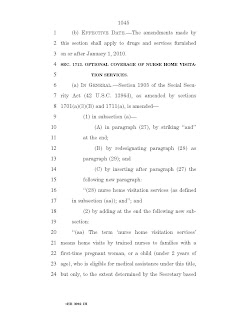the shocking fertility and family control provisions in health care reform legislation
Gwendolyn Mink, Ph.D. and Dorothy Roberts, J.D.
While the latest clash over health care reform has focused on abortion funding, no attention has been paid to a shocking fertility and family control provision slipped into the House health care bill. Many reform opponents are up in arms over imaginary state intervention in medical care. But the House bill actually would authorize state intervention in a plan to monitor the childbearing decisions and family lives of low-income women.
The House health care bill (H.R. 3962), contains a provision affecting Medicaid recipients who are pregnant for the first time or who have a child under two years of age. Section 1713 allows States to use Medicaid funds for non-medical home visits by nurses to advance certain goals affecting reproductive decisions and family life. The goals include: "increasing birth intervals between pregnancies," "reducing maternal and child involvement in the criminal justice system," "increasing economic self-sufficiency," and "reducing dependence on public assistance."
These goals of the home visitation program have nothing to do with providing health care. Instead, they are based on the false premise that poor mothers’ childbearing is to blame for social problems. The proposed visitation program is eugenicist, deceptive, discriminatory against low-income women, and utterly inappropriate to the medical work of nurses.
Under the program envisioned in the House bill, government-sponsored medical professionals are charged with exhorting fertility control among poor women, based on the mistaken premise that reproduction among the poor leads to crime, neglect, low educational attainment, and dependency. According to the government's own statistics, –families receiving welfare have, on average, only 1.8 children; half the families receiving welfare have only one child, and only one in ten have more than three children.
http://www.acf.hhs.gov/programs/ofa/data-reports/annualreport8/chapter10/chap10.htm#4
Although the data show that poverty is not correlated with family size -- and that childbearing does not cause poverty -- the U.S. House of Representatives seeks to tell low-income women who receive medical assistance how many children to have and when to have them.
The House health care bill codifies some of the worst stereotypes of low-income mothers, suggesting that bad reproductive choices and misguided family practices make their families poor. Similarly, the provision blames low-income mothers for raising criminals and accuses them of maintaining unstable and neglectful home lives for their children.
Black mothers in particular have been subjects of deeply-embedded stereotypes about sexual and reproductive irresponsibility that have supported a long legacy of repressive state policies, including sterilization and coerced birth control. The mythical “welfare queen,” portrayed as a black woman who deliberately becomes pregnant to increase the amount of her monthly check, was propaganda used to support welfare reform. Several state legislators even proposed bills requiring women to use birth control or undergo sterilization as a condition of receiving welfare benefits. Immigrant women and other women of color have suffered similar injustices that devalue their reproductive decision making, as well as their parental rights and family practices.
These statutory devices and impositions should sound familiar to anyone aware of the 1996 welfare reform law. It too pivoted on the idea that regulating poor women's reproduction would end their need for welfare. Congress transformed welfare from a system of aid to a system of behavior modification that attempts to control the sexual, marital, and childbearing decisions of poor unmarried mothers by placing conditions on the receipt of state assistance. Section 1713 interprets literally the language of "pathology" from the welfare debate in its plan to "cure" the putative effects of poverty by curing poor mothers' fertility and motherhood.
We applaud the lawmakers who have banded together to take a stand against inclusion of the Stupak amendment in the final bill. But we urge them look beyond Stupak - to support a vision of reproductive justice that extends beyond abortion and respects the childbearing decisions and mothering of all women. Health care reform must not only ensure the right to abortion but also must protect the full spectrum of women's reproductive and family rights. Congress can start to promote the well-being of all women by rejecting eugenicist provisions such as the home visitation program. Any visiting nurse program in health care legislation should stick to providing medical care regardless of economic or social status. Economically vulnerable women should not be treated as sitting ducks for social engineers.
____________________
Gwendolyn Mink, Ph.D., an independent scholar, is co-editor of the two-volume Poverty in the
Dorothy Roberts, J.D., the Kirkland & Ellis Professor, Northwestern University Law School, and Professor, Departments of African-American Studies and Sociology, is the author of Killing the Black Body: Race, Reproduction, and the Meaning of Liberty and of Shattered Bonds: The Color of Child Welfare. She can be contacted at d-roberts@law.northwestern.edu


